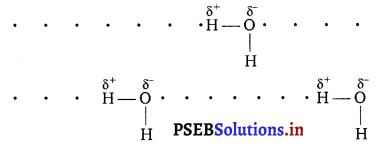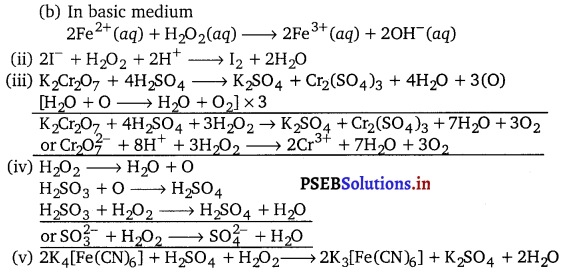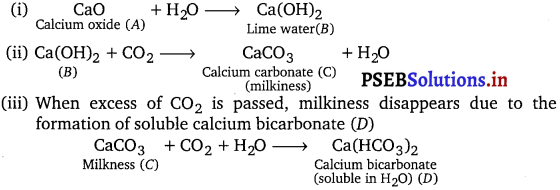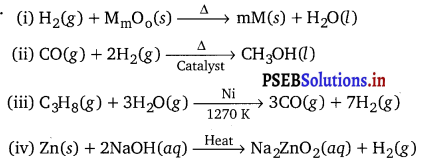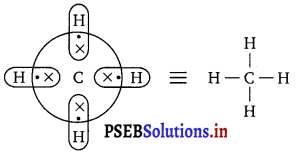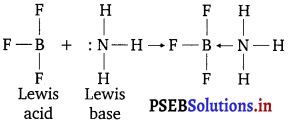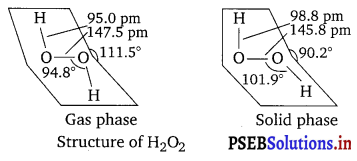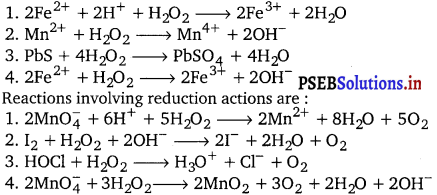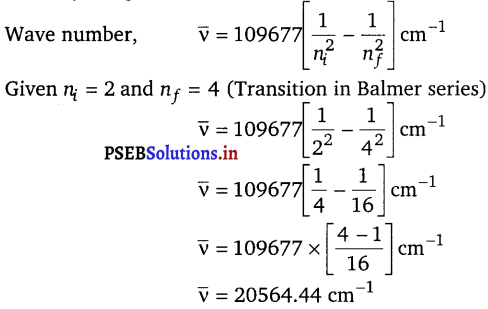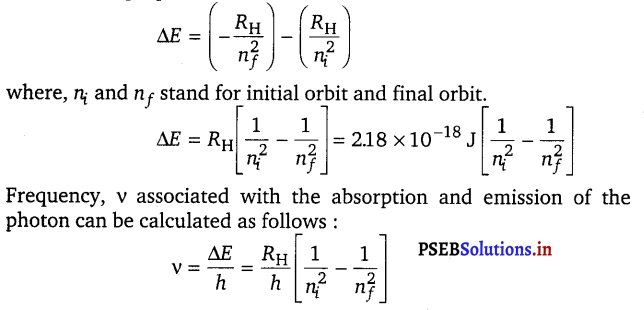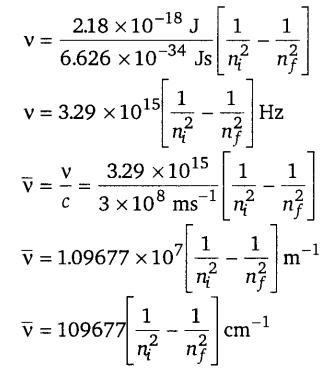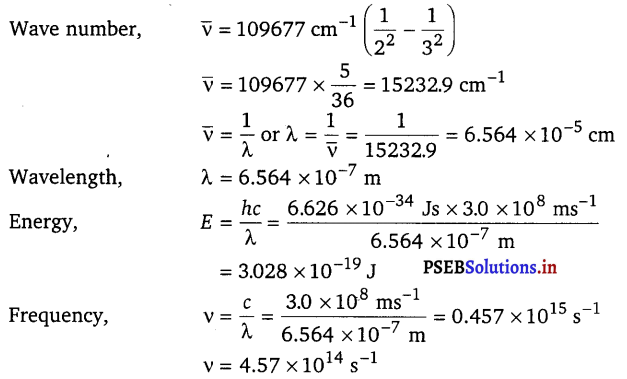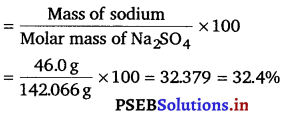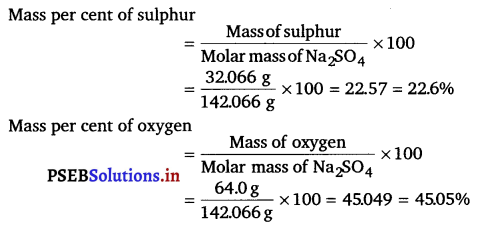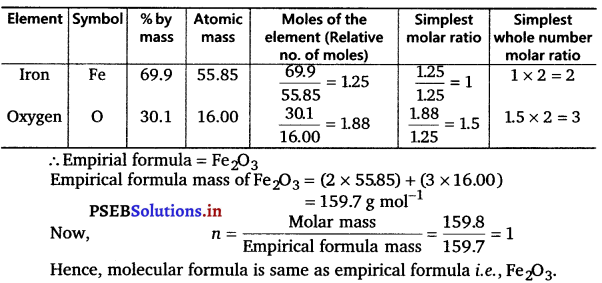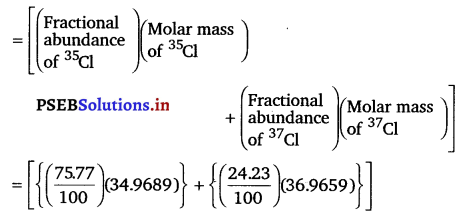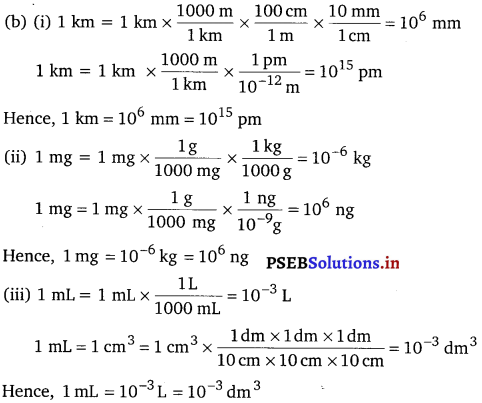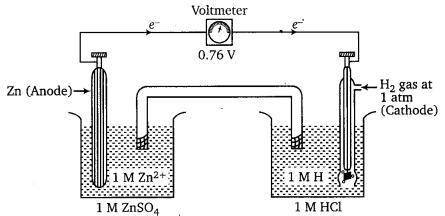Punjab State Board PSEB 11th Class Chemistry Book Solutions Chapter 8 Redox Reactions Textbook Exercise Questions and Answers.
PSEB Solutions for Class 11 Chemistry Chapter 8 Redox Reactions
PSEB 11th Class Chemistry Guide Redox Reactions InText Questions and Answers
Question 1.
Assign oxidation numbers to the underlined elements in each of the following species:

Answer:
(a) Let the oxidation number of P be x.
Oxidation number of Na = +1
Oxidation number of H = +1
Oxidation number of O = – 2
In neutral compounds, the sum of the oxidation numbers of all the atoms is zero.
1 (+1) + 2 (+1) +1 00 + 4 (-2) = 0
1 + 2 + x – 8 = 0
3 + x + (-8) – 0
x = 8 – 3
⇒ x = + 5
Hence, the oxidation number of P is +5.
(b) Let the oxidation number of S be x.
![]()
1 (+1) +1 (+1) +1 (x) + 4 (-2) = 0
⇒ 1 + 1 + x – 8 = 0
⇒ x = + 6
Hence, the oxidation number of S is +6.
(c) Let the oxidation number of P be x.
![]()
4 (+1) + 2 (x) + 7 (-2) = 0
⇒ 4 + 2x – 14 = 0
⇒ 2x = +10
⇒ x = + 5
Hence, the oxidation number of P is + 5.
![]()
(d) Let the oxidation number of Mn is x.
![]()
2 (+1) + x + 4 (-2) = 0
⇒ 2 + x — 8 = 0
⇒ x = + 6
Hence, the oxidation number of Mn is + 6.
(e) Let the oxidation number of O be x.
![]()
1 (+ 2) + 2 (x) = 0
⇒ 2 + 2x = 0
⇒ x = – 1
Hence, the oxidation number of O is -1.
(f) Let the oxidation number of B be x.
![]()
1 (+1)+1 (x) + 4 (-1) = 0
⇒ 1 + x – 4 = 0
⇒ x = + 3
Hence, the oxidation number of B is + 3.
(g) Let the oxidation number of S is x.

2 (+1) + 2 (x) + 7 (-2) = 0
⇒ 2 + 2x -14 = 0
⇒ 2x = +12
x = +6
Hence, the oxidation number of S is + 6.
(h) Let the oxidation number of S be x.

1 (+1) +1 (+ 3) + 2 (x) + 8 (-2) +12 (2 x 1 + (-2)) = 0
⇒ 1 + 3 + 2x -16 + 24 – 24 = 0
⇒ 2x = 12
x = + 6
Hence, the oxidation number of S is + 6.
Question 2.
What are the oxidation number of the underlined elements in each of the following and how do you rationalise your results?
![]()
![]()
Answer:
(a) In
![]()
the oxidation number (O. N.) of K is +1. Hence, the average oxidation number of I is \(\frac{-1}{3}\). However, O.N. cannot be fractional.
Therefore, we will have to consider the structure of KI3 to find the oxidation states.
In a KI3 molecule, an atom of iodine forms a coordinate covalent bond with an iodine molecule.

![]()
Hence, in a KI3 molecule, the O.N. of the two I atoms forming the I2 molecule is 0, whereas the O.N. of the I atom forming the coordinate bond is -1.
(b) Let the oxidation number of S be x.
![]()
2 (+1) + 4 (x) + 6 (-2) = 0
=» 2 + 4x – 12 = 0
⇒ 4x = +10
⇒ x = + 2 \(\frac{1}{2}\)
However, O.N. cannot be fractional. Hence S must be present in different oxidation states in the molecule.

The O.N. of two of the four S atoms is +5 and the O.N. of the other two S atoms is 0.
(c) Let the oxidation number of Fe be x.
![]()
3(x) + 4(-2) = 0
3x – 8 = 0
x = \(+\frac{8}{3}\)
However O.N. cannot’be fractional. Here, one of the three Fe atoms exhibits the O.N. of +2 and the other two Fe atoms exhibit the O.N. of+3
(d) Let oxidation number of C be x.
![]()
2 (x) + 6 (+1) + 1 (-2) = 0
2x + 4 = 0
x = -2
Hence, the O.N. of C is – 2
(e) Let the oxidation number of C be x.
![]()
2 (x) + 4 (+1) + 2 (-2) = 0
2x = 0
x = 0
Therefore, the average oxidation number of C is zero.
Let us consider the structure of CH3COOH

Oxidation number of atom = 1(+1) + x+1(-2) +1(-1) = 0
x = +2
Similarly, oxidation number of C2 atom
3(+1) + x+ 1(-1) = 0
x = -2.
Question 3.
Justify that the following reactions are redox reactions:
(a) CuO (s) + H2(g) → Cu(s) + H2O(g)
(b) Fe2O3 (s) + 3CO(g) → 2Fe(s) + 3CO2(g)
(c) 4BCl3 (g) + 3LiAlH4 (s) → 2B2H6(g) + 3LiCl (s) + 3 AlCl3(S)
(d) 2K (s) + F2 (g) → 2K+F–(s)
(e) 4NH3(g) + 5O2(g) → 4NO(g) + 6H2O (g)
Answer:
(a) CuO (s) + H2(g) → Cu(s) + H2O(g)
Let us write the oxidation number of each element involved in the given reaction as :
![]()
Here, the oxidation number of Cu decreases from +2 in CuO to 0 in Cu i.e., CuO is reduced to Cu. Also, the oxidation number of H increases from 0 in H2 to +1 in H2O i.e., H2 is oxidized to H2O. Hence, this reaction is a redox reaction.
(b) Fe2O3 (s) + 3CO(g) → 2Fe(s) + 3CO2(g)
Let us write the oxidation number of each element in the given reaction as:

Here, the oxidation number of Fe decreases from +3 in Fe2O3 to 0 in Fe i.e., Fe2O3 is reduced to Fe. On the other hand, the oxidation number of C increases from +2 in CO to +4 in CO2 i.e., CO is oxidized to CO2.
Hence, the given reaction is a redox reaction.
(c) 4BCl3 (g) + 3LiAlH4 (s) → 2B2H6(g) + 3LiCl (s) + 3 AlCl3(S)
The oxidation number of each elements in the given reaction can be represented as:
![]()
In this reaction, the oxidation number of B decreases from +3 in BCl3 to -3 in B2H6- i.e., BCl3 is reduced to B2H6. Also, the oxidation number of H increases from -1 in LiAlH4 to +1 in B2H6 i.e., LiAlH4 is oxidized to B2H6. Hence, the given reaction is a redox reaction.
(d) 2K (s) + F2 (g) → 2K+F–(s)
The oxidation number of each element in the given reaction can be represented as:
![]()
In this reaction, the oxidation number of K increases from 0 in K to +1 in KF i.e., K is oxidized to KF. On the other hand, the oxidation number of F decreases from 0 in F2 to -1 in KF i.e., F2 is reduced to KF.
Hence, the above reaction is a redox reaction.
(e) 4NH3(g) + 5O2(g) → 4NO(g) + 6H2O (g)
The oxidation number of each elements in the given reaction can be represented as:
![]()
Here, the oxidation number of N increases from -3 in NH3 to +2 in NO. On the other hand, the oxidation number of O2 decreases from 0 in O2 to -2 in NO and H2O i.e.,O2 is reduced. Hence, the given reaction is a redox reaction.
Question 4.
Fluorine reacts with ice and results in the change:
H2O(S) + F2(g) → HF(g) + HOF(g)
Justify that this reaction is a redox reaction.
Ans. Let us write the oxidation number of each atom involved in the given reaction above its symbol as:
![]()
Here, we have observed that the oxidation number of F increases from 0 in F2 to +1 in HOF. Also, the oxidation number decreases from 0 in F2 to -1 in HF. Thus, in the above reaction, F is both oxidized and reduced. Hence, the given reaction is a redox reaction.
![]()
Question 5.
Calculate the oxidation number of sulphur, chromium and nitrogen in H2SO5, \(\mathrm{Cr}_{2} \mathrm{O}_{7}^{2-}\) and \(\mathrm{NO}_{3}^{-}\). Suggest structure of these compounds. Count for the fallacy.
Answer:
![]()
2 (+1) +1 (x) + 5 (-2) = 0
⇒ 2 + x -10 = 0
⇒ x = + 8
However, the O.N. of S cannot be +8. S has six valence electrons. Therefore, the O.N. of S cannot be more than +6. The structure of H2S05 is shown as follows :
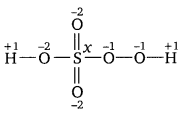
Now, 2 (+1) +1 (x) + 3 (-2) + 2 (-1) – 0
⇒ 2 + x – 6 – 2 = 0
⇒ x = + 6
Therefore, the O.N. of S is +6.
![]()
2 (x) + 7 (-2) = – 2 ⇒ 2x -14 = – 2
⇒ x = + 6
The structure of Cr2Oy is shown as follows:
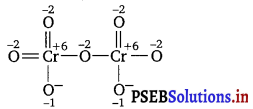
Let the oxidation number of each Cr atom be
4(-2) + (-2) +1(-2) + 2x = 0
– 8 – 2 – 2 + 2x = 0
2x = +12
x = +6
Oxidation number of Cr in \(\mathrm{Cr}_{2} \mathrm{O}_{7}^{2-}\) is same.
Hence, there is no fallacy.
![]()
1 (x) + 3(-2) = -1
= x – 6 = -1
x = +5
The structure of \(\mathrm{NO}_{3}^{-}\) is shown as follows:

Let the oxidation number of N be x.
1(-1) + x + 1(-2) + 1(-2) = 0
x = + 5
Oxidation number of N in \(\mathrm{NO}_{3}^{-}\) ion is same.
Hence, there is no fallacy.
Question 6.
Write formulas for the following compounds:
(a) Mercury (II) chloride
(b) Nickel (II) sulphate
(c) Tin (IV) oxide
(d) Thallium (I) sulphate
(e) Iron (III) sulphate
(f) Chromium (III) oxide
Answer:
(a) Mercury (II) chloride: Hg (II) Cl2
(b) Nickel (II) sulphate: Ni (II) SO4
(c) Tin (IV) oxide : Sn (IV) O2
(d) Thallium (I) sulphate: Tl2 (I) SO4
(e) Iron (III) sulphate: Fe2(III) (SO4)3
(f) Chromium (III) oxide: Cr2(III)O3
![]()
Question 7.
Suggest a list of the substances where carbon can exhibit oxidation states from -4 to +4 and nitrogen from -3 to +5.
Answer:
The substances where carbon can exhibit oxidation states from -4 to +4 are listed in the following table :
| Substance | Formula | Oxidation State of Carbon |
| Methane | CH4 | -4 |
| Ethane | C2H6 | -3 |
| Ethene | C2H4 | -2 |
| Ethyne | C2H2 | -1 |
| Dichloromethane | CH2Cl2 | 0 |
| Hexachlorobenzone | C6Cl6 | +1 |
| Carbon monoxide | CO | +2 |
| Oxalic acid | (COOH)2 | +3 |
| Carbon dioxide | CO2 | +4 |
The substances where nitrogen can exhibit oxidation sates from -3 to +5 are listed in in the following table.
| Substance | Formula | Oxidation State of Nitrogen |
| Ammonia | NH3 | -3 |
| Hydrazine | N2H4 | -2 |
| Hydride | N2H2 | -1 |
| Dinitrogen gas | N2 | 0 |
| Nitrous oxide | N2O | +1 |
| Nitric oxide | NO | +2 |
| Dinitrogen trioxide | N2O3 | +3 |
| Nitrogen dioxide | NO2 | +4 |
| Nitrogen pentoxide | N2O5 | +5 |
Question 8.
While sulphur dioxide and hydrogen peroxide can act as oxidising as well as reducing agents in their reactions, ozone and nitric acid act only as oxidants. Why?
Answer:
(i) In sulphur dioxide (SO2), the oxidation number (O.N.) of S is +4 and the range of the O.N. that S can have is from +6 to -2.
Therefore, SO2 can act as an oxidising as well as reducing agent.
(ii) In hydrogen peroxide (H2O2), the O.N. of O is -1 and the range of the O.N. that O can have is from 0 to -2. O can sometimes also attain the oxidation numbers +1 and +2. Hence, H2O2 can act as an oxidising as well as reducing agent.
(iii) In ozone (O3) the O.N. of O is zero and the range of the O.N. that O can have is from 0 to -2. Therefore, the O.N. of O can only decrease in this case. Hence,O3 acts only as an oxidant.
(iv) In nitric acid (HNO3) the O.N. of N is +5 and the range of the O.N. that N can have is from +5 to -3. Therefore, the O.N. of N can only decrease in this case. Hence, HNO3 acts only as an oxidizing agent.
Question 9.
Consider the reactions:
(a) 6CO2(g) + 6H2O(l) → C6H12O6 (aq) + 6O2(g)
(b) O3(g) + H2O2(Z) → H2O(1) + 2O2(g)
Why it is more appropriate to write these reactions as:
(a) 6CO2 (g) + 12H2O(1) → C6H12O6 (aq) + 6H2O(l) + 6O2 (g)
(b) O3(g) + H2O2(Z) → + H2O(Z) + O2(g) + O2(g)
Also suggest a technique to investigate the path of the above (a) and (b) redox reactions.
Answer:
(a) The process of photosynthesis involves two steps :
Step 1: H2O decomposes to give H2 and O2.
2H2O(l) → 2H2(g) + O2(g)
Step 2: The H2 produced in step 1 reduces CO2 thereby producing glucose (C6H12O6) and H2O.
6CO2(g) + 12H2(g) → C6H12O6(S) + 6H2O(l)
Now, the net reaction of the process is given as:

It is more appropriate to write the reaction as given above because water molecules are also produced in the process of photosynthesis.
The path of this reaction can be investigated by using radioactive H2O18 in place of H2O
![]()
(b) O2 is produced from each of the two reactants O3 and H2O2. For this reason O2 is written twice.
The given reaction involves two steps. First O3 decomposes to form O2 and O. In the second step H2O2 reacts with the O produced in the first step thereby producing H2O and O2.

The path of this reaction can be investigating by using \(\mathrm{H}_{2} \mathrm{O}_{2}^{18}\) or \(\mathrm{O}_{3}^{18}\).
Question 10.
The compound AgF2 is unstable compound. However, if formed, the compound acts as a very strong oxidizing agent. Why?
Answer:
AgF2 → Ag + F2
The oxidation state of Ag in Ag F2 is +2. But +2 is an unstable oxidation state of Ag. Therefore, whenever Ag F2 is formed, silver readily accepts an electron to form Ag+. This helps to bring the oxidation state of Ag down from +2 to a more stable state of +1. As a result, Ag F2 acts as a very strong oxidizing agent.
Question 11.
Whenever a reaction between an oxidising agent and a reducing agent is carried out, a compound of lower oxidation state is formed if the reducing agent is in excess and a compound of higher oxidation state is formed if the oxidising agent is in excess. Justify this statement giving two illustrations.
Answer:
Whenever a reaction between an oxidising agent and a reducing agent is carried out, a compound of lower oxidation state is formed if the reducing agent is in excess and a compound of higher oxidation state is formed if the oxidising agent is in excess. This can be illustrated as follows:
(i) P4 and F2 are reducing and oxidising agents respectively.
If an excess of P4 is treated with F2 then PF3 will be produced, where in the oxidation number (O.N.) of P is +3.
![]()
However, if P4 is treated with an excess of F2, then PF5 will be produced, wherein the O.N. of P is +5.
![]()
(ii) K acts as a reducing agent, whereas O2 is an oxidising agent.
If an excess of K reacts with O2, then K2O will be formed, wherein the O.N. of O is -2.

However, if K reacts with an excess of O2, then K2O2 will be formed, wherein the O.N. of O is -1.
![]()
Question 12.
How do you account for the following observations?
(a) Though alkaline potassium permanganate and acidic potassium permanganate both are used as oxidants, yet in the manufacture of benzoic acid from toluene we use alcoholic potassium permanganate as an oxidant. Why? Write a balanced redox equation for the reaction.
(b) When concentrated sulphuric acid is added to an inorganic mixture containing chloride, we get colourless pungent smelling gas HCl, but if the mixture contains bromide then we get red vapour of bromine. Why?
Answer:
(a) Oxidation of toluene to benzoic acid in acidic medium.

Oxidation of toluene to benzoic acid in basic and neutral medium.

On industrial scale, alcoholic potassium permanganate is preferred to acidic or alkaline potassium permanganate because in the presence of alcohol, both the reactants KMnO4 and C6H5CH3 are mixed very well and form homogeneous solution and in homogeneous medium reaction takes place faster than in heterogeneous medium. Further more in neutral medium, OH– ions are produced in the reaction itself.
(b) ![]()
HCl is a weak reducing agent. k cannot reduce H2SO4 to SO2 that’s why pungent smelling gas HCl is obtained.

HBr is a strong reducing agent, it reduces H2S04 to SO2 and is itselfoxidised to Br2. That’s why we get red vapours of bromine when conc.
H2SO4 reacts with inorganic mixture containing bromide salt.
Question 13.
Identify the substance oxidised, reduced, oxidising agent andreducing agent for each of the following reactions:
(a) 2AgBr(s) + C6H6O2(aq) → 2Ag(s) + 2HBr(aq) + C6H4O2(aq)
(b) HCHO(l) +2 [Ag (NH3)2]+ (aq) + 3OH–(aq) → 2Ag(s) + HCOO–(aq) + 4NH3(aq) + 2H2O (l)
(c) HCHO(l) + 2Cu2+ (aq) + 5 OH– → Cu2O (s) +HCOO–(aq) + 3H2O(l)
(d) N2H4 (Z) + 2H2O2 (1) → N2 (g) + 4H2O (l)
(e) Pb (s) +PbO2 (s) + 2H2SO4 (ag) → 2PbSO4(s) + 2H2O(l)
Answer:
(a) Oxidised substance -C6H6O2
Reduced substance – AgBr
Oxidising agent – AgBr
Reducing agent -C6H6O2
(b) Oxidised substance – HCHO
Reduced substance – [Ag (NH3)2]+
Oxidising agent – [Ag (NH3)2]+
Reducing agent – HCHO
(c) Oxidised substance – HCHO
Reduced substance -Cu2+
Oxidising agent – Cu2+
Reducing agent – HCHO
![]()
(d) Oxidised substance – N2H4
Reduced substance -H2O2
Oxidising agent-H2O2
Reducing agent -N2H4
(e) Oxidised substance – Pb
Reduced substance – PbO2
Oxidising agent – Pb O2
Reducing agent – Pb
Question 14.
Consider the reactions:

Why does the same reductant, thiosulphate react differently with iodine and bromine?
Answer:
The average oxidation number (O.N.) of S in \(\mathrm{S}_{2} \mathrm{O}_{3}^{2-}\) is +2. Being a stronger oxidising agent than I2, Br2 oxidises \(\mathrm{S}_{2} \mathrm{O}_{3}^{2-}\) to \(\mathrm{S}_{2} \mathrm{O}_{4}^{2-}\) in which the O.N. of S is +6. However I2 is a weak oxidising agent. Therefore, it oxidises \(\mathrm{S}_{2} \mathrm{O}_{3}^{2-}\) to \(\mathrm{S}_{4} \mathrm{O}_{6}^{2-}\) in which the average O.N. of S is only +2.5. As a result, \(\mathrm{S}_{2} \mathrm{O}_{3}^{2-}\) reacts differently with iodine and bromine. ,
Question 15.
Justify giving reactions that among halogens, fluorine is the best oxidant and among hydrohalic compounds, hydroiodic acid is the best reductant.
Answer:
(i) F2 can oxidize Cl– to Cl2, Br– to Br2 and I– to I2 as:
F2(aq) + 2Cl–(s) → 2F–(aq) + Cl2(g)
F2(aq) + 2Br–(aq) → 2F–(aq) + Br2(7)
F2(aq) + 2I–(aq) → 2F–(aq) + I2(s)
On the other hand, Cl2, Br2 and I2 cannot oxidize F– to F2. The oxidizing power of halogens increases in the order of I2 < Br2 < Cl2 < F2. Hence fluorine is the best oxidant among halogens.
(ii) HI and HBr can reduce H2SO4 to SO2, but HCl and HF cannot. Therefore HI and HBr are stronger reductants than HCl and HF.
2HI + H2SO4 → I2 + SO2 + 2H2O
2HBr + H2SO4 → Br2 + SO2 + 2H2O
Again, I- can reduce Cu2+ to Cu+ but Br– cannot.
4I–(aq) + 2Cu2+(aq) → Cu2I2(s) + I2(aq)
Hence, hydroiodic acid is the best reductant among hydrohalic compounds.
Thus, the reducing power of hydrohalic acids increases in the order of
HF < HCl < HBr < HI.
![]()
Question 16.
Why does the following reaction occur?
\(\mathrm{XeO}_{6}^{4-}\)(aq) + 2F– (aq) + 6H+(aq) → XeO3(g) +F2(g) + 3H2O(i)
What conclusion about the compound Na4XeO6 (of which \(\mathrm{XeO}_{6}^{4-}\) is a part) can be drawn from the reaction.
Answer:
The given reaction occurs because \(\mathrm{XeO}_{6}^{4-}\) oxidizes being an oxidizing agent and F– reduces \(\mathrm{XeO}_{6}^{4-}\)
![]()
In this reaction, the oxidation number (O.N.) of Xe decreases from +8 in \(\mathrm{XeO}_{6}^{4-}\) to +6 in XeO3 and the O.N. of F increases from -1 in F– to 0 in F2.
Hence, we can conclude that Na4XeO6 is a strong oxidizing agent thanF–.
Question17.
Consider the reactions:
(a) H3PO2 (aq) + 4 AgNO3 (aq) + 2H2O(l) → H3PO4 (aq) + 4Ag(s) + 4HNO3 (aq)
(b) H3PO2 (oqr) + 2CuSO4 (aq) + 2 H2O(0 → H3PO4 (aq) + 2Cu(s) +H2SO4 (aq)
(c) C6H5CHO(l) + 2[Ag (NH3)2]+ (aq) + 3OH– (aq) → C6H5COO–(aq) + 2Ag(s) + 4NH3 (aq) + 2H2O(l)
(d) C6H5CHO(l) + 2Cu2+(aq) + 5OH–(aqf) → No change observed.
What inference do you draw about the behaviour of Ag+ and Cu2+ from these reactions?
Answer:
Ag+ and Cu2+ act as an oxidizing agents in reactions (a) and (b) respectively.
In reaction (c), Ag+ oxidizes C6H5CHO to C6H5COO–, but in reaction (d) Cu2+ cannot oxidize C6H5CHO. Hence, we can say that Ag+ is a stronger oxidising agent than Cu2+.
Question 18.
Balance the following redox reactions by ion-electron method:


Answer:
(a) Step 1 : The two half reactions involved in the given reaction are:
Oxidation half reaction :
![]()
Reduction half reaction:
![]()
Step 2 : Balancing I in the oxidation half reaction, we have
2I– (aq) → I2(s)
Now, to balance the charge, we add 2 e“ to the RHS of the reaction.
2I–(aq) → I2(s) + 2e–
Step 3 : In the reduction half reaction, the oxidation state of Mn has reduced from +7 to +4. Thus, 3 electrons are added to the LHS of the reaction.
\(\mathrm{MnO}_{4}^{-}\) + 3e– → MnO2(aq)
Now, to balance the charge, we add 4 OH“ ions to the RHS of the reaction as the reaction is taking place in a basic medium.
\(\mathrm{MnO}_{4}^{-}(a q)^{-}\) + 3e– → MnO2(aq) + 4OH–
Step 4 : In this equation, there are 6 O atoms on the RHS and 4 O atoms on the LHS. Therefore, two water molecules are added to the LHS.
\(\mathrm{MnO}_{4}^{-}\) (aq) + 2H2O + 3e– → MnO2(aq) + 4OH–
Step 5 : Equalising the number of electrons by multiplying the oxidation half reaction by 3 and the reduction half reaction by 2, we have:
6I–(aq) → 3I2(s) + 6e–
2 \(\mathrm{MnO}_{4}^{-}\)(aq) + 4H2O + 6e– → 2MnO2(s) + 8OH–(aq)
Step 6 : Adding the two half reactions, we have the net balanced redox reaction as:
6I–(aq) + 2\(\mathrm{MnO}_{4}^{-}\)(aq) + 4H2O(l) → 3I2(s) + 2MnO2(s) + 8OH–(aq)
(b) Following the steps as in part (a) we have the oxidation half reaction as:
SO2(g) + 2H2O(Z) → \(\mathrm{HSO}_{4}^{-}\)(aq) + 3H+ (aq) + 2e– (aq)
And the reduction half reaction as:
\(\mathrm{MnO}_{4}^{-}\)(aq) + 8H+(aq) + 5e– → Mn2+(aq) + 4H2O(l)
Multiplying the oxidation half reaction by 5 and the reduction half reaction by 2, and then by adding them, we have the net balanced redox reaction as :
2Mno4–(aq) + 5SO2(g) + 2H2O(Z) + H+(aq) → 2Mn(aq) + 5HSO4–((aq)
(c) Following the steps as in part (a), we have the oxidation half reaction as:
Fe2+(aq) → Fe3+(aq) + e–
And the reduction half reaction as:
H2O2(aq) + 2H+ (aq) + 2e– → 2H2O(l)
Multiplying the oxidation half reaction by 2 and then adding it to the reduction half reaction, we have the net balanced redox reaction as:
H2O2(aq) + 2Fe2+(aq) + 2H+(aq) → 2Fe3+ (aq) + 2H2O(Z)
(d) Following the steps as in part (a), we have the oxidation half reaction as:

![]()
Question 19.
Balance the following equations in basic medium by ion-electron method and oxidation number methods and identify the oxidising agent and the reducing agent.
(a) P4(s) + OH–(aq) → PH3(g) + H2PO2–(aq)
(b) N2H4(l) + CIO3–(aqr) → NO(g) + Cl–(g)
(c) Cl2O7(g) + H2O2(aqr) → ClO–2(aq) + O2(g) + H+
Answer:

O.N. increases by 1 per P atom.
P4 acts both as an oxidising as well as a reducing agent.
Oxidation number method:
Total decrease in O.N. of P4 in PH3 = 3 x 4 = 12
Total increase in O.N. of P4 in H2PO2 = 1 x 4 = 4
Therefore, to balance increase/decrease in O.N. multiply PH3 by 1 and H2PO2– by 3, we have,
P4(s) + OH–(aq) → PH3(g) + 3H2PO2–(aq)
To balance O atoms, multiply OH- by 6, we have,
P4(s) + 6OH–(aq) → PH3(g) + 3H2PO2–(aq)
To balance H atoms, add 3H2O to L.H.S. and 3OH– to the R.H.S. we have,
P4 (s) + 6OH–(aq) + 3H2O(l) → PH3(g) + 3H2PO2–(aq) + 3OH–(aq)
or P4(s) + 3OH–(aq) + 3H2O(l) → PH3(g) + 3H2PO2–(aq) …(1)
Thus, Eq. (1) represents the correct balanced equation.
Ion-electron method : The two half reactions are:

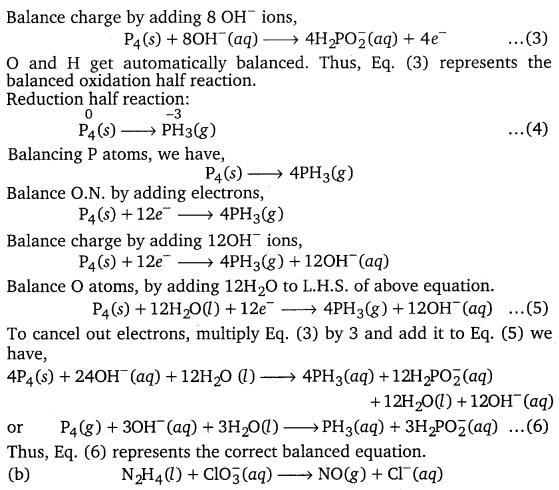
Oxidation number method :
Total increase in O.N. of N = 2 x 4 = 8
Total decrease in O.N. of Cl = 1 x 6 = 6
Therefore, to balance increase/decrease in O.N. multiply N2H2 by 3 and \(\mathrm{ClO}_{3}^{-}\) by 4, we have,
3N2H4(l) + 4ClO3– (aq) → NO(g) + Cl–(aq)
To balance N and Cl atoms, multiply NO by 6 and Cl– by 4, we have,
3N2H4(l) + 4ClO3–(aq) → 6NO(g) + 4Cl–(aq)
Balance O atoms by adding 6H2O, in R.H.S.
3N2H4(l) + 4ClO3–(aq) → 6NO(g) + 4Cl–(aq) + 6H2O (l) …(1)
H atoms get automatically balanced and thus Eq. (1) represents the correct balanced equation.
Ion electron method :
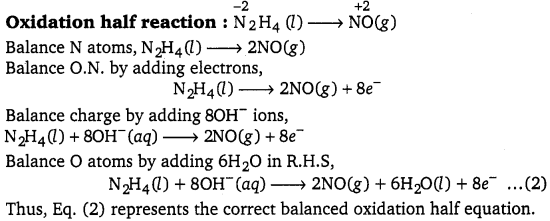
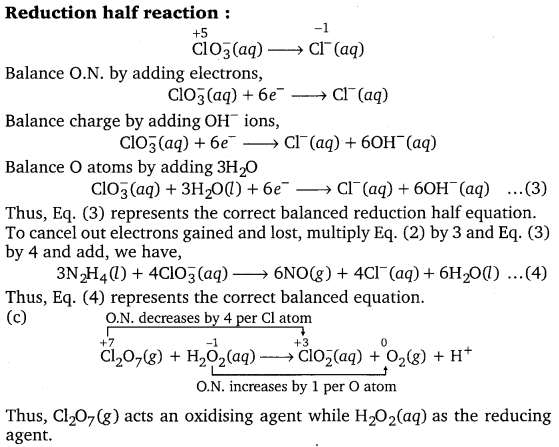
Oxidation number method :
Total decrease in O.N. of Cl2O7 = 4 x 2 = 8
Total increase in O.N. of H2O2 = 2 x 1 = 2
∴ To balance increase/decrease in O.N. multiply H2O2 and O2 by 4, we have,
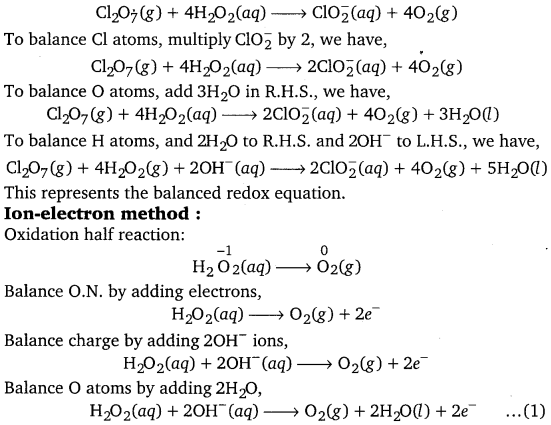
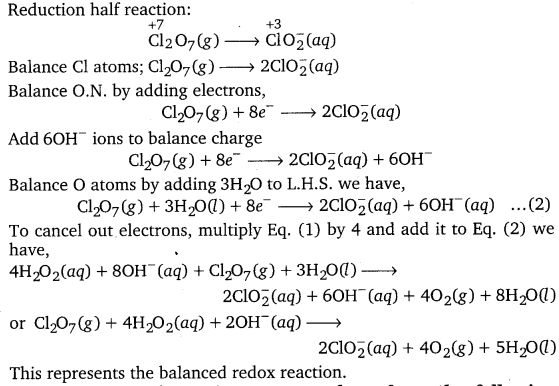
![]()
Question 20.
What type of information can you draw from the following reaction?
(CN)2(g) + 2OH–(aq) → CN–(aq) + CNO–(aq) + H2O(l)
Answer:
The oxidation number of carbon in (CN)2 CN– and CNO– is +3, +2 and +4 respectively. These are obtained as shown below:
Let the oxidation number of C be x.
(i) (CN)2
2 (x – 3) = 0
∴ x = +3
(ii) CN–
x -3 = -1
∴ x = +2
(iii) CNO–
x – 3 – 2 = -1
∴ x = + 4
The oxidation number of carbon in the various species is:

The following information we can drawn from the above reaction :
(i) Decomposition of cyanogen in the cyanide ion (CN–) and cyanate ion (CNO–) occurs in basic medium.
(ii) Cyanogen (CN)2 acts as both reducing agent as well as oxidising agent.
(iii) The reaction is an example of disproportionation reaction.
(iv) Cyanogen (CN)2 is called pseudohalogen while CN–, CNO– ions are called pseudohalide ions.
Question 21.
The Mn3+ ion is unstable in solution and undergoes disproportionation to give Mn2+, MnO2 and H+ ion. Write a balanced ionic equation for the reaction.
Answer:
The given reaction can be represented as:
Mn3+ (aq) → Mn2+(aq) + MnO2(s) + H+(aq)
The oxidation half equation is:
![]()
The oxidation number is balanced by adding one electron as:
Mn3+(aq) → MnO2(s) + e–
The charge is balanced by adding 4H+ ion as :
Mn3+(aq) → MnO2(s) + 4H+ (aq) + e–
The O atoms and H+ ions are balanced by adding 2H20 molecules as:
Mn3+(aq) + 2H2O(l) → MnO2(s) + 4H+ (aq) + e– …(1)
The reduction half equation is:
Mn3+(aq) → Mn2+(aq)
The oxidation number is balanced by adding one electron as :
Mn3+ (aq) + e– → Mn2+ (aq) … (2)
The balanced chemical equation can be obtained by adding equation (1) and (2) as :
2Mn3+(aq) + 2H2O(l) → MnO2(s) + Mn2+(aq) + 4H+(aq)
Question 22.
Consider the elements: Cs, Ne, I and F
(a) Identify the element that exhibits only negative oxidation state.
(b) Identify the element that exhibits only positive oxidation state.
(c) Identify the element that exhibits both positive and negative oxidation states.
(d) Identify the element which exhibits neither the negative nor the positive oxidation state.
Answer:
(a) F exhibits only negative oxidation state of-1.
(b) Cs exhibits only positive oxidation state of +1
(c) I exhibits both positive and negative oxidation states. It exhibits oxidation states of-1, 0, +1, + 3, + 5, and + 7.
(d) The oxidation state of Ne is zero. It exhibits neither negative nor positive oxidation states.
Question 23.
Chlorine is used to purify drinking water. Excess of chlorine is harmful. The excess of chlorine is removed by treating with sulphur dioxide. Present a balanced equation for this redox change taking place in water.
Answer:
The given redox reaction can be represented as:

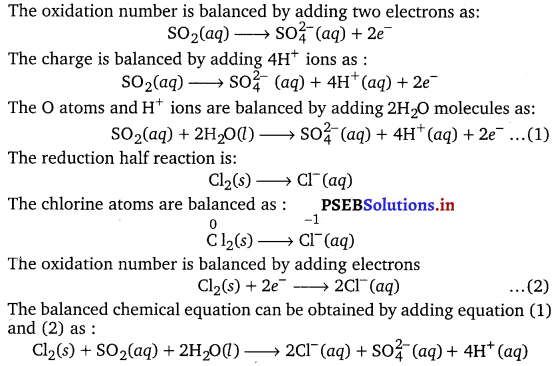
Question 24.
Refer to the periodic table given in your book and now answer the following questions:
(a) Select the possible non-metals that can show disproportionation reaction.
(b) Select three metals that can show disproportionation reaction.
Answer:
In disproportionation reaction, one of the reacting substances always contains an element that can exist in at least three oxidation states.

![]()
Question 25.
In Ostwald’s process for the manufacture of nitric acid, the first step involves the oxidation of ammonia gas by oxygen gas to give nitric oxide gas and steam. What is the maximum weight of nitric oxide that can be obtained starting only with lO.OOg of ammonia and 20.00 g of oxygen?
Answer:
The balanced chemical equation for the given reaction is given as:

68 g of NH3 reacts with 160 g of O2
Therefore 10 g of NH3 reacts with \(\frac{160 \times 10}{68}\). g of O2 or 23.53 g of O2
But the available amount of O2 is 20 g which is less than the amount required to react with 10 g NH3. So, O2 is the limiting reagent and it limits the amount of NO produced. From the above balanced equation.
160 g of O2; produces 120 g NO.
Therefore, 20 g of O2; produces = \(\frac{120 \times 20}{160}\) = 15 g NO
Question 26.
Using the standard electrode potentials given in the table 8.1,
predict if the reaction between the following is feasible: *
(a) Fe3+ (aq) and I– (aq)
(b) Ag+ (aq) and Cu (s)
(c) Fe3+ (aq) and Cu(s)
(d) Ag (s) and Fe3+ (aq)
(e) Br2 (aq) and Fe2+(aqr)
Answer:
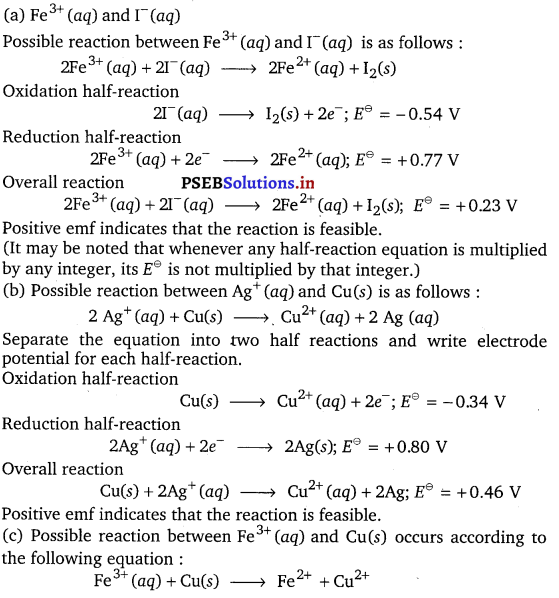
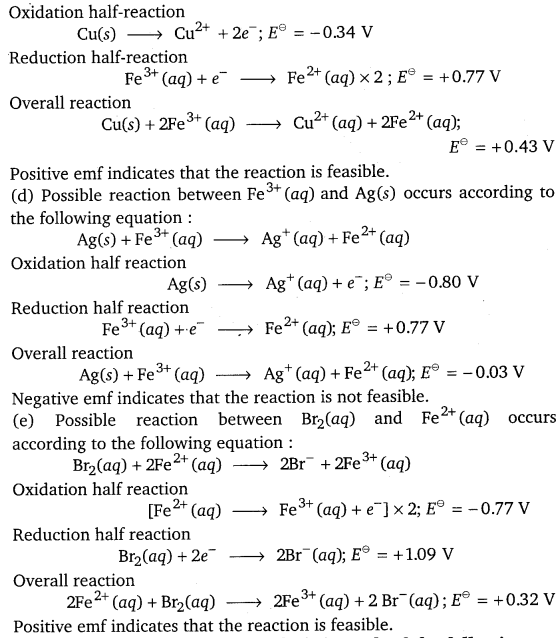
Question 27.
Predict the products of electrolysis in each of the following:
(i) An aqueous solution of AgNO3 with silver electrodes.
(ii) An aqueous solution of AgNO3 with platinum electrodes
(iii) A dilute solution of H2SO4 with platinum electrodes.
(iv) An aqueous solution of CuCl2 with platinum electrodes,
Answer:
(i) AgNO3 ionizes in aqueous solutions to form Ag+ and \(\mathrm{NO}_{3}^{-}\) ions.
On electrolysis, either Ag+ ions or H2O molecules can be reduced at the cathode. But the reduction potential of Ag+ ions is higher than that of H2O.

Hence, Ag+ ions are reduced at the cathode. Similarly, Ag metal or H20 molecules can be oxidized at the anode. But the oxidation potential of Ag is higher than that of H20 molecules.
Ag(s) → Ag+(aq) + e– ;\(E^{\ominus}\) = -0.80V
2H2O2(g) → O2(g) + 4H+(aq) + 4e– ;\(E^{\ominus}\) = -1.23V
Therefore, Ag metal gets oxidized at the anode.
![]()
(ii) Pt cannot be oxidized easily. Hence, at the anode, oxidation of water occurs to liberate O2. At the cathode, Ag+ ions are reduced and get deposited.
(iii) H2SO4 ionizes in aqueous solutions to give H+ and \(\mathrm{SO}_{4}^{2-}\) ions.
H2SO4 (aq) → 2H+(aq) + \(\mathrm{SO}_{4}^{2-}\) (aq)
On electrolysis, either of H+ ions or H2O molecules can get reduced at the cathode. But the reduction potential of H+ ions is higher than that of H2O molecules.
2H+(aq) + 2e– → H2(g); \(E^{\ominus}\) = 0.0 V
2H2O(aq) + 2e– → H2(g) + 2OH–(aq): \(E^{\ominus}\) = – 0.83V
Hence, at the cathode, H+ ions are reduced to liberate H2 gas.
On the other hand, at the anode, either of \(\mathrm{SO}_{4}^{2-}\) ions or H2O molecules can get oxidized. But the oxidation of \(\mathrm{SO}_{4}^{2-}\) involves breaking of more bonds than that of H2O molecules. Hence, \(\mathrm{SO}_{4}^{2-}\) ions have a lower oxidation potential than H2O. Thus, H2O is oxidized at the anode to liberate O2 molecules.
(iv) In aqueous solutions, CuCl2 ionizes to give Cu2+ and Cl– ions as
CuCl2 (aq) → Cu2+ (aq) + 2Cl– (aq)
On electrolysis either of Cu2+ ions or H2O molecules can get reduced at the cathode. But the reduction potential of Cu2+ is more than that of H2O molecules.
Cu2+(aq) + 2e– → Cu(aq) ;\(E^{\ominus}\) = + 0.34V ;
H2O(l) + 2e– → H2(g) + 2OH– ;\(E^{\ominus}\) = – 0.83V
Hence, Cu2+ ions are reduced at the cathode and get deposited.
Similarly, at the anode, either of Cl– or H2O is oxidized. The oxidation , potential of H2O is higher than that of Cl–
2Cl–(aq) → Cl2(g) + 2e– ;\(E^{\ominus}\) = -1.36V :K
2H2O(l) → O2(g) + 4H+(aq) + 4e– ;\(E^{\ominus}\) = -1.23V
But oxidation of H2O molecules occurs at a lower electrode potential . than that of Cl– ions because of over-voltage (extra voltage required to liberate gas). As a result, Cl– ions are oxidized at the anode to liberate Cl2 gas. :
Question 28.
Arrange the following metals in the order in which they displace each other from the solution of their salts.
Al, Cu, Fe, Mg and Zn. ‘
Answer:
A metal of stronger reducing power displaces another metal of weaker reducing power from its solution of salt.
The order of the increasing reducing power of the given metals is
Cu < Fe < Zn < Al < Mg. Hence, we can say that Mg can displace Al from its salt solution, but Al cannot displace Mg. Thus, the order in which the given metals displace each other from the solution of their salts is given below:
Mg > Al > Zn > Fe > Cu
Question 29.
Given the standard electrode potentials:
K+ / K = – 2.93V, Ag+ / Ag = 0.80 V, Hg2+ /Hg = 0.79 V
Mg2+/ Mg = -2.37 V, Cr3+/Cr = -0.74 V Arrange these metals in their increasing order of reducing power.
Answer:
The lower the electrode potential, the stronger is the reducing agent. Therefore, the increasing order of the reducing power of the given metal is
Ag < Hg < Cr < Mg < K.
![]()
Question 30.
Depict the galvanic cell in which the reaction Zn(s) + 2Ag+(aqr) → Zn2+(aqr) + 2Ag(s) takes place, further show:
(i) which of the electrode is negatively charged,
(ii) the carriers of the current in the cell, and
(iii) individual reaction at each electrode.
Answer:
The galvanic cell corresponding to the given redox reaction can be represented as:
Zn / Zn2+ (aq) | | Ag+(aq) / Ag
(i) Zn electrode is negatively charged because at this electrode, Zn oxidizes to Zn2+ and the leaving electrons accumulate on this electrode.
(ii) Ions are the carriers of current in the cell.
(iii) The reaction taking place at Zn electrode can be represented as:
Zn(s) → Zn2+ (aq) + 2e–
and the reaction taking place at Ag electrode can be represented as:
Ag+(aq) + e– → Ag(s)


